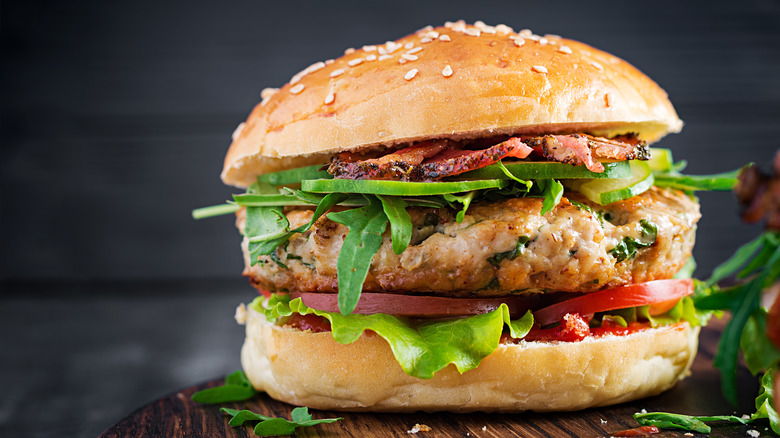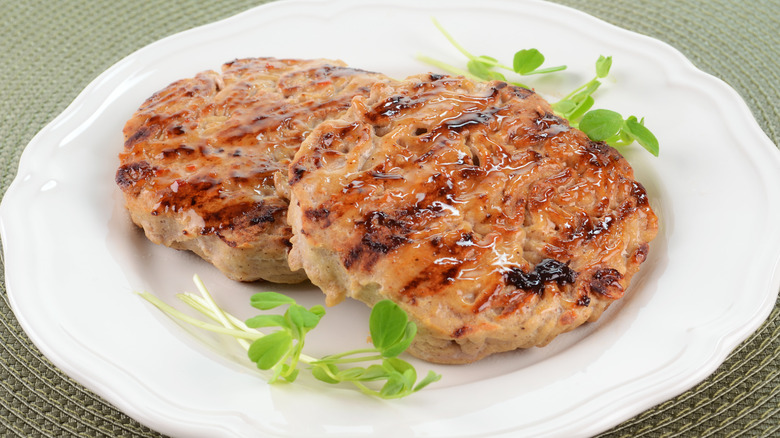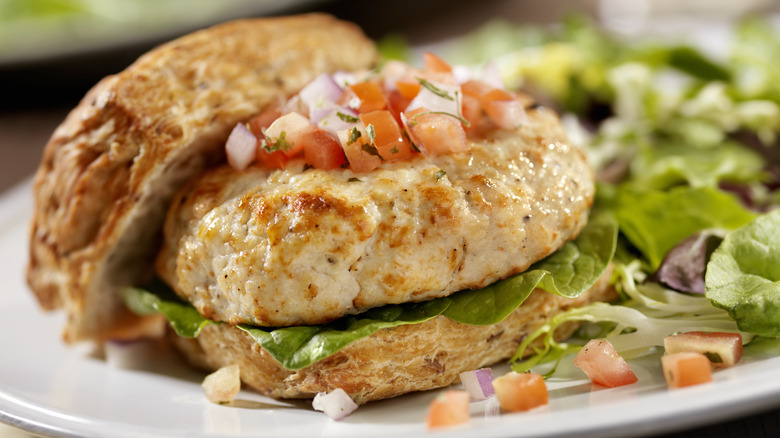A Juicy Turkey Burger All Comes Down To The Type Of Grill
A good, well-made turkey burger can truly be delicious, rivaling even a classic beef burger under the right circumstances. But it's also an easy dish to get wrong, and turkey patties can quickly fall victim to dryness, underseasoning, and other mistakes that'll leave your sandwich tasting sub-par.
One of the biggest errors home cooks make when preparing turkey burgers is trying to grill them like any other burger — especially on a traditional backyard charcoal grill. While barbecue grills can impart major flavor when it comes to fatty beef, for turkey burgers, it's important to keep that fat and those juices contained with the meat for moisture. Otherwise, it'll just drip out through the grates and into the coals, leaving the turkey high and dry, robbing the patty of all the extra flavor.
A flat-top grill is by far the best cooking tool for a turkey burger. Searing turkey patties on a flat surface gives that nice golden-brown sear and baste the meat in the rendered fat and juices, maintaining moisture and leaving you with a tender, tasty burger.
Cooking turkey burgers on a bbq grill
While cooking on a flat-top is ideal, if you're dead-set on cooking turkey burgers on your outdoor grill, there are a few ways to combat dryness. To start, always choose ground turkey with a higher fat content; this will prevent the patties from drying out as quickly. Ground turkey meat that's 90% to 93% or even lower, if you can find it, will work the best.
Coating your patties in a high-fat dairy product such as mayonnaise, sour cream, or full-fat yogurt can help maintain flavor and moisture on the grill. Mayo especially imparts a creamy tang to the patties, while the fat content in the condiment seals in the turkey's juices and helps baste and insulate it while cooking. The end result will still have those nice char marks on the exterior from a turn on the grill, but the interior of the patty will be as succulent and juicy as if you'd cooked it in a pan.
Major mistakes when making turkey burgers
With something as simple as a burger, every decision impacts the final product, from the choice of meat to the toppings. As mentioned above, since bird meat is already so lean, getting a little extra fat in there can be useful to prevent sticking, crumbling, and drying out. Higher fat content also means more dark meat in the ratio, which imparts more flavor.
You may also be tempted to overcook a turkey patty, given that the USDA doesn't recommend medium-rare turkey meat. But even though your patty should be cooked through, that doesn't mean it should be scorched or shriveled. Use a thermometer to check the internal temperature if you have one — when it hits 165 degrees Fahrenheit, it's finished.
Finally, be limited with your mix-ins. Seasoning is important with turkey, and so is a binder to keep the patties together. A little egg and breadcrumbs will do — but not too much. You want the flavor of the turkey to come through and the texture to be patty-like, not akin to meatloaf.


